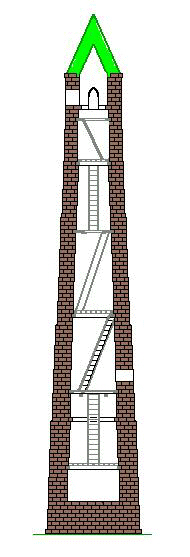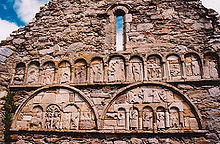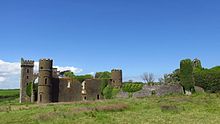Ardmore (Ireland)
Ardmore ( Irish Aird Mhór , older Ard Mhór Dhéagláin , "Declan's great foothills") is a place on the R673 (road) on the south coast of the Republic of Ireland in County Waterford . The next larger towns are Youghal in the west and Dungarvan in the northeast. The population of Ardmore has changed little since 1996 and was 434 people in the 2016 Census.
The Romanesque church in Ardmore, and especially the round tower, are among the most important of their kind. The first monastery in Ardmore was founded by St. Declan ( Decclain ). He is considered a pillar of Christianity in southern Ireland and is said to have been bishop of the Irish Scottish Church in Munster when St. Patrick arrived.
From 1591 to 1593, Ardmore was owned by Sir Walter Raleigh . In 1642 the Irish rebel army holed up in the church and in the round tower and was besieged by the English. When she surrendered, 117 out of 154 insurgents were hanged on the spot.
The church
Ardmore Church was built by Moel-Ettrim Ó Duibh-rathra before his death in 1203. Probably the rest of an older church was integrated. The church had a bishop from 1170 and has been run as Ardmore Cathedral ever since . It has unusual structural features such as the Romanesque west window and the pointed choir arch. The most original, however, are the arcades and sculptures on the west wall, which are arranged above and below two rows of arcades. The scenes above a series of small arches have crumbled off, but the Archangel Michael, who cradles souls, can be recognized. Adam and Eve, the judgment of Solomon and the adoration of the wise can be seen below the large arches.
The two ogham stones from Ardmore are also located in the church ruins . It is an Irish national monument .
The round tower
The round tower rises in five floors to a height of 30 m and is one of the best preserved in the British Isles .
The oratorio
To the east of the church is the small St. Declan's Oratory , which was re-roofed in 1716. It is believed to be the Church of the Holy Sepulcher of St. Declan. A depression in the southeast corner is identified as his grave.
Ardoginna House
South of the village, near the cliffs, are the ruins of Ardoginna House , a castle-like, formerly representative complex with towers and fortifications from the 16th century. In 1920/21 the house was given up by its owners at the time, the MacKenna family. It was looted and has since fallen into disrepair.
Holy spring
St. Declan's Holy Well belongs to a hermitage near the old monastery. The fountain dates back to the 5th century and is still a place of religious devotion. On July 24th, many devotees visit the hermitage and drink the water from the well.
See also
literature
- Peter Harbison : Guide to National and Historic Monuments of Ireland . 3rd ed. Gill & Macmillan Publ., Dublin 1992, ISBN 0-7171-3239-0 pp. 236-237
Individual evidence
- ↑ Map of Ireland (can be enlarged greatly)
- ^ Ardmore (Town) on citypopulation.de, accessed on May 25, 2019
Coordinates: 51 ° 57 ′ N , 7 ° 44 ′ W




